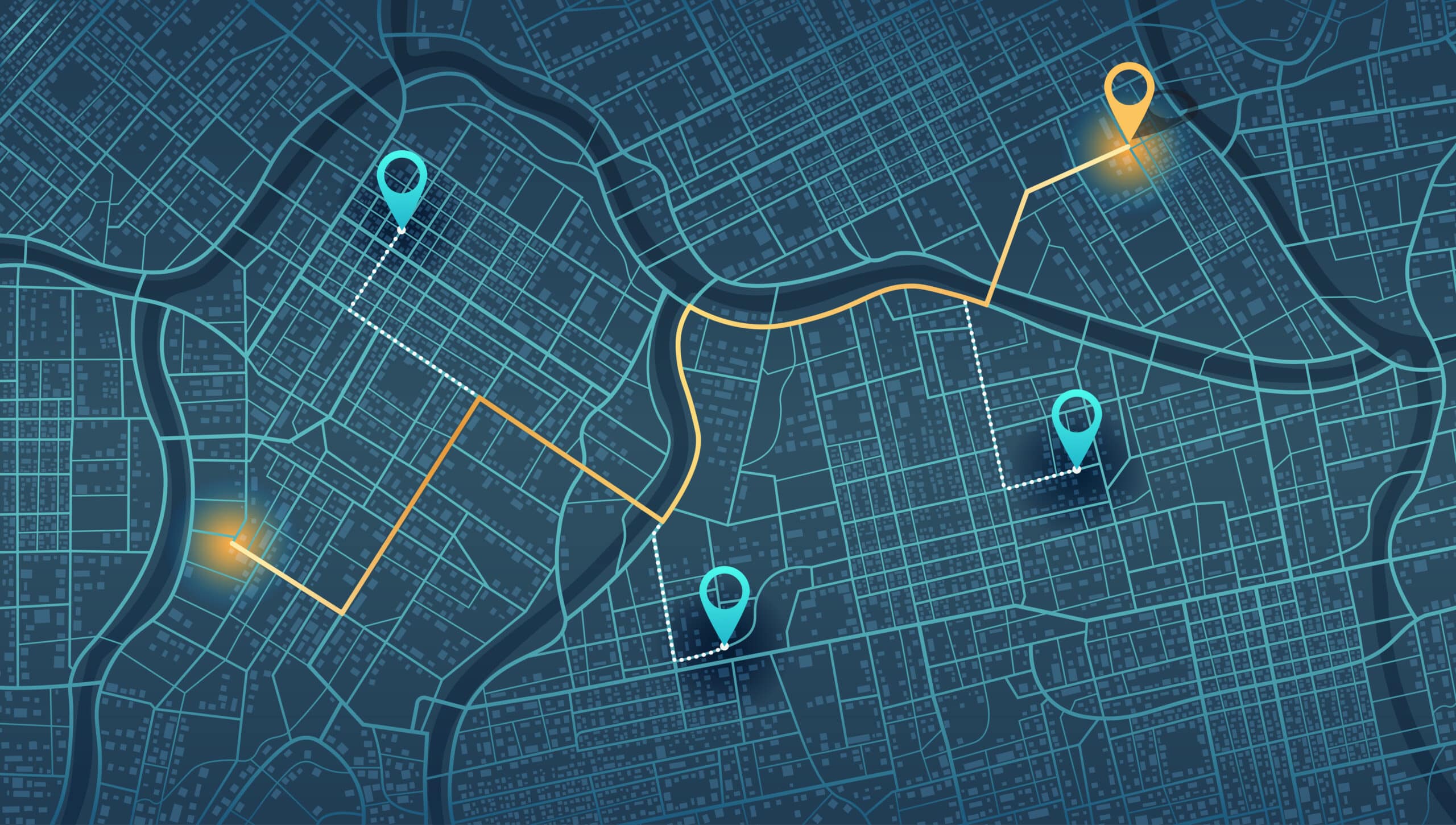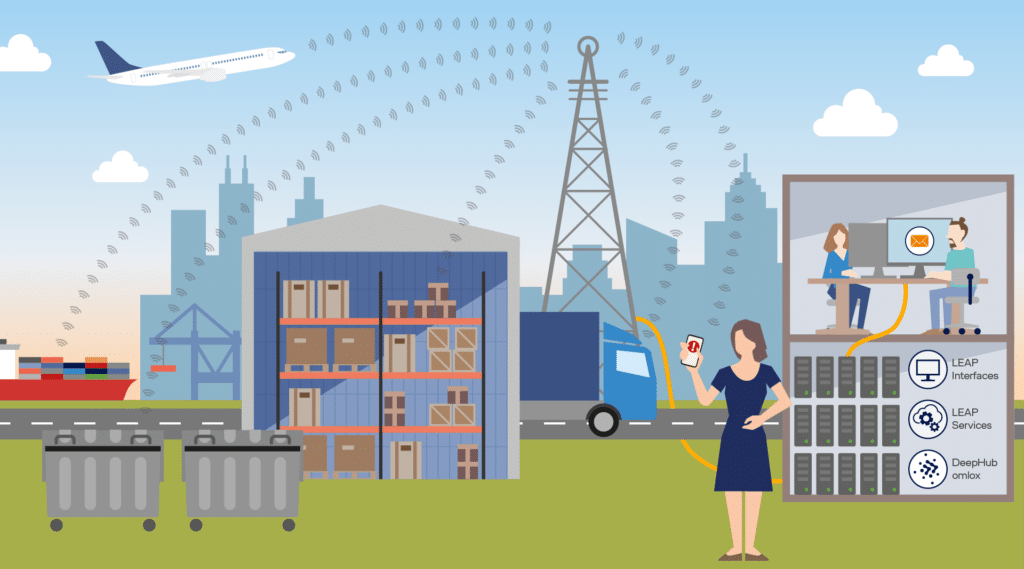The manufacturing and logistics industries, pillars of the global economy, are presently undergoing a radical transformation. Amid escalating costs and the need for superior flexibility, the time has come for these sectors to adopt innovative, scalable solutions that can navigate the waters of this fast-paced, technology-driven world. Standing tall at the forefront of this transformation is the emerging business model of Device-as-a-Service (DaaS) coupled with the power of real-time location data.
This article provides an in-depth exploration of the DaaS model, highlighting its benefits for companies currently leveraging, or considering, real-time locating systems. Using Lufthansa Industry Solutions as a prime example, we illustrate the strategic implementation of DaaS, mainly in outdoor use, which provides clear advantages for their customers.
How the Device-as-a-Service (DaaS) Approach Leads to Less Complexity and Reduces Financial Risks
As industries delve deeper into the era of digitization and automation, the sheer speed and complexity of modern business operations demand real-time responsiveness. Gone are the days when businesses could afford to rely solely on periodic reviews and updates. In today’s fast-paced environment, companies need instantaneous data to make split-second decisions, adapt to rapidly changing scenarios, and maintain a competitive edge. The evolution of global markets, the desire for just-in-time production, and customer expectations for immediate gratification have all contributed to this shift.
Managing business operations has, thus, increasingly become a real-time activity, where delays or outdated information can translate into missed opportunities, financial losses, or compromised customer satisfaction. Manufacturing and logistics, being at the heart of product and service delivery, are no exceptions. The use of real-time location data in these sectors has become indispensable. It provides companies with unprecedented visibility into any moving object within complex supply chains, whether it’s raw materials, finished products, or crucial machinery. By being able to track goods from production to delivery, locate assets within sprawling warehouses, optimize routes based on real-time conditions, and predict maintenance needs before machinery breakdowns occur, businesses can ensure efficiency, reduce waste, and better serve their customers. This high level of granularity in tracking and data analytics is redefining the very foundations upon which the manufacturing and logistics industries operate.
However, these advancements come with their challenges. Developing and maintaining the infrastructure required to access and utilize real-time location data can be prohibitively expensive, both in terms of financial costs and the need for specialized expertise. This is where the DaaS model enters the picture.
The DaaS model, essentially an extension of the cloud computing service model, allows businesses to rent devices such as tags and anchors on a subscription basis instead of investing heavily in purchasing and maintaining them. It offers flexibility, scalability, and significant cost savings, making it a perfect fit for the contemporary business landscape. The financial burden of procuring, managing, and updating devices is lifted, paving the way for businesses to focus more on core operations and less on managing complex hardware infrastructures.
How Does this Tie in with Location Data?
The incorporation of DaaS in the context of real-time location data brings about a symbiotic relationship that further augments its advantages. Real-time tracking devices used in manufacturing and logistics, such as GPS trackers, RFID tags, Bluetooth beacons, and Wi-Fi anchors, are pivotal in modern operations but come with their set of challenges. For instance, while RFID tags have become quite affordable over time, their counterparts, the RFID readers, still carry a heftier price tag. Ultra-Wideband (UWB) tags, on the other hand, remain a premium choice due to their higher costs. The most significant investment, however, often lies in the anchors. Regardless of the technology — be it RFID, Bluetooth, Wi-Fi, or UWB — the anchors usually represent the priciest component, with UWB being the most expensive across the board. The overall expense for tags also varies based on the quantity required and the chosen technology, with RFID presenting a cost-effective option in contrast to the pricier UWB. A DaaS model helps companies avoid the high upfront costs of these devices and the ongoing expenses associated with their upkeep.
With DaaS, businesses can readily scale their operations according to demand without worrying about hardware procurement or capital expenditure. They can deploy the latest technologies at a fraction of the cost and with far less effort. Additionally, DaaS providers often offer round-the-clock support and service, ensuring that the rented devices function optimally at all times.

DaaS Ensures Operational Continuity and Champions Sustainable Practices
In manufacturing and logistics, any downtime can translate to substantial financial losses. The DaaS model addresses this challenge head-on by ensuring continuous and uninterrupted access to vital real-time location data. Whether a device malfunctions or is due for an upgrade, the onus is on the DaaS provider to promptly replace or update it. This approach means that manufacturing and logistics enterprises can proactively mitigate potential disruptions, ensuring that their operations run smoothly and efficiently.
Beyond the operational advantages, the DaaS model is making significant strides in championing sustainability. By promoting a circular economy, DaaS encourages the reuse and recycling of devices. This not only minimizes electronic waste but also plays a pivotal role in resource conservation. As the global spotlight on environmental sustainability intensifies, companies are under increasing scrutiny to adopt and showcase eco-friendly practices. DaaS provides them with a tangible way to address these concerns, embodying both operational excellence and environmental stewardship.
Lufthansa Industry Solutions: Pioneering DaaS for Logistics and Industry Partners
Lufthansa Industry Solutions (LHIND) is a subsidiary of the Lufthansa Group, specializing in IT consulting and services. Catering primarily to the logistics and manufacturing sectors, LHIND offers innovative IoT solutions, aiding businesses in their digital transformation journey. The Device-as-a-Service (DaaS) model is a prime example of the innovative solutions that LHIND offers.
In this context, LHIND provides the necessary IT infrastructure for real-time tracking within the framework of the DaaS model, covering the entire process end-to-end. This includes:
- Device financing
- Configuration and provisioning
- Maintenance, exchange, and return
- Training and support
- Deployment and operation of the real-time locating system
- Device lifecycle management
With low barriers to entry, DaaS is available for both purchase and rental models starting from as few as 50 devices. Their flagship product LEAP (Locating Engine and Analytics Platform), ensures instant access and currently connects devices that are used for outdoor tracking. It supports functionalities such as historical data, event management, a dedicated front-end, and a versatile app. The entire offering is crafted to be flexible, with a modular service structure encompassing device shipping, refurbishing, disposal, and financing. It’s further enhanced by the LHIND device ecosystem and open interfaces that offer myriad integration opportunities into existing environments.
The DeepHub plays a crucial role since it enables LEAP to stream location data from any positioning technology or vendor, providing standardized integrations and full interoperability. The DeepHub is a leading location middleware based on the global, open standard for location technologies, omlox. LEAP uses DeepHub technology as a central element for the management of real-time location data and thus supports the omlox standard. By incorporating the DeepHub, LHIND harnesses a state-of-the-art engine that can power complex location-aware solutions. The company currently specializes primarily in outdoor tracking. However, it has already established the technical groundwork for comprehensive end-to-end tracking, encompassing both outdoor and indoor transitions. LHIND plans to further develop these components in the future.

Interview with Holger Schlüter
In our exploration of this use case, we engaged in a conversation with Holger Schlüter, Business Development at Lufthansa Industry Solutions. We delved into the core aspects of their DaaS offering to glean essential insights.
Mr. Schlüter, what is meant by “Device as a Service”?
Holger Schlüter: To put it simply, Device as a Service (DaaS) encompasses all the services and benefits required to use infrastructure without the need to worry about it. This can even include infrastructure financing.
Do you actually see a need in the market for DaaS?
Holger Schlüter: Yes, for two significant reasons. First, there’s a shift from capital expenditure (CAPEX) to operational expenditure (OPEX), and second, there are operational savings in device management.
What specific services do you offer under DaaS?
Holger Schlüter: We offer a range of services, including IT services, device management services, device monitoring services, device lifecycle services, logistics, provisioning, repair, and financial services.
When is it worth starting with DaaS?
Holger Schlüter: DaaS has low barriers to entry, making it a viable option starting from as few as 50 devices.
You mentioned the benefits of shifting from CAPEX to OPEX. Could you explain this in more detail?
Holger Schlüter: Certainly. Shifting from CAPEX to OPEX reduces investment risk by lowering capital expenditure. It also offers tax benefits and accounting benefits. You can find more information on the difference between CAPEX and OPEX here.
Can you elaborate on the types of devices that benefit from DaaS?
Holger Schlüter: Sure, there are two primary types of devices that benefit from DaaS. First, there’s a focus on devices that don’t operate within a fixed infrastructure. This is because there’s high demand for sensor technology in transport across numerous touchpoints and locations. The journey of these trackers doesn’t stop at the loading ramp; it needs to be viewed end-to-end. Indoor tracking plays a crucial role here, which requires specialized knowledge that many companies prefer to outsource, especially in terms of device maintenance and management. Companies often concentrate on software, while hardware management can be a challenge. They prefer not to be responsible for operational business and seek to outsource it. LHIND has substantial experience in this area and offers scalable solutions. The low barriers to entry make it accessible for small-scale deployments because very few start with 5,000 devices.
Why do companies opt for DaaS services?
Holger Schlüter: Companies choose DaaS services primarily for the benefits it offers in terms of managing devices efficiently and cost-effectively. DaaS allows businesses to focus on their core operations while outsourcing device-related tasks, such as maintenance, provisioning, and repairs. It provides flexibility, scalability, and significant cost savings, which are crucial in today’s fast-paced business environment. Additionally, DaaS ensures operational continuity and supports sustainability efforts by promoting the reuse and recycling of devices. As the demand for real-time location data and smart label technologies continues to grow, DaaS becomes an essential solution for modern businesses looking to stay competitive and environmentally responsible.
Conclusion: The Unmatched Potential of DaaS in Transforming Modern Logistics and Manufacturing
The DaaS model, underpinned by the robustness of real-time location data, is set to transform the logistics and manufacturing industries fundamentally. It provides a solution to the rising costs, offers unparalleled flexibility, and ensures access to real-time data, which has become a cornerstone of modern operations.
In this fast-paced world, businesses that recognize and adapt to these shifts will be the ones to secure their place in the future. Embracing the DaaS model in conjunction with real-time location data offers them the opportunity to do just that: to streamline their operations, reduce costs, improve scalability, and ensure they stay at the forefront of the technological wave sweeping across the logistics and manufacturing sectors.
The DaaS model is not merely an emerging trend in the logistics and manufacturing industries; it is a strategic imperative in today’s world, dictating the very terms of survival and success in these fields. This new model, no doubt, is the way forward, redefining business operations for the modern age.
Lufthansa Industry Solutions is a pioneer in this field and we are proud to empower the LEAP platform with a powerful locating middleware. That makes DeepHub a pivotal element in driving DaaS infrastructures for real-time location solutions. Discover our RTLS platform, seamlessly compatible with the globally-recognized omlox standard, here: Discover DeepHub
